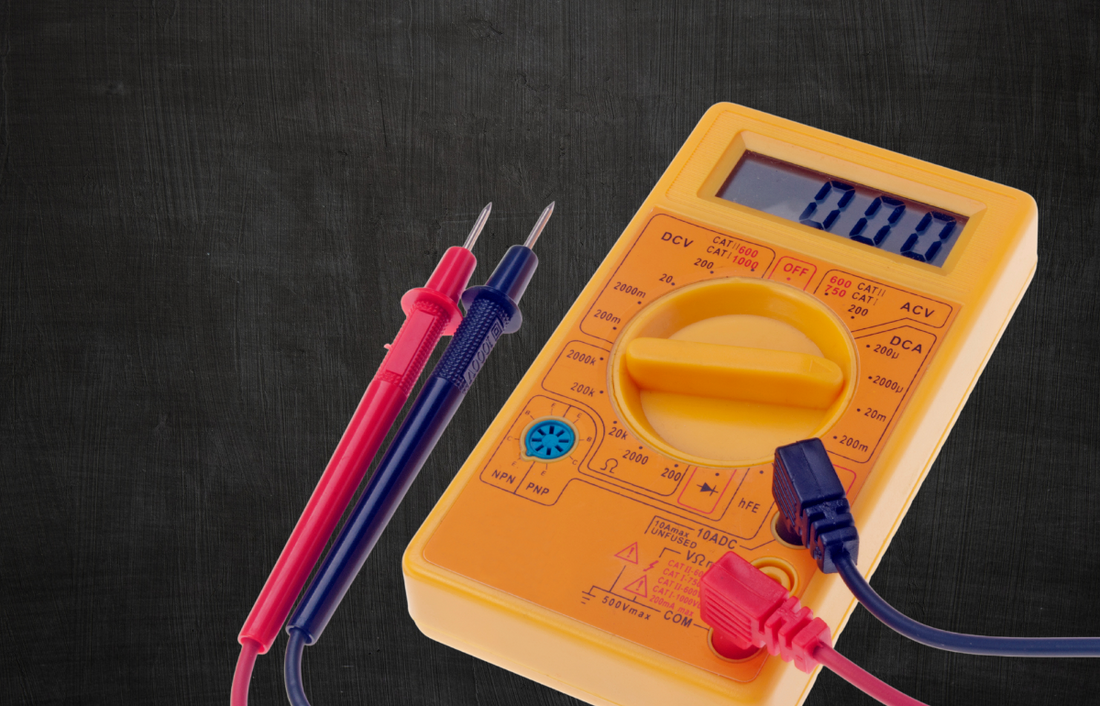Many people have turned to grounding mats to enhance their health and well-being. And there is a simple and efficient way to test these mats! Prepare your multimeters, as we are about to unveil the secrets of precisely testing your grounding bed pads or grounding mats with the help of step-by-step instructions!
Summary:
To test a grounding mat or grounding pad for your bed using a multimeter, first plug in your grounding product and attach the black cord to the COM port of the meter. Next, attach the red cord to the VΩHz port of the multimeter and connect it to an alligator clip.
Secure the alligator clip onto the black connection patch or the underside of the grounding mat. Set the multimeter to the AC Volts setting.
Hold the opposite metal end between your fingers while standing on the mat or touching anywhere on its surface with your opposite hand. The multimeter screen should display decreasing voltage readings, indicating that your body is grounded.
Now let's delve into how to test grounding mats for your bed.

Preparing to Test a Grounding Mat with a Multimeter
It is vital to maintain an ideal grounding voltage, typically between 0.00 V and 2 mV (millivolts), for optimal effectiveness when using earthing products, as per the National Safety Council guidelines. Using a multimeter helps ensure proper grounding voltage while testing grounding mats.
However, before you start testing your grounding mat with a multimeter, it is crucial to prepare adequately. Let's discuss the preparations required, including equipment cleaning and checking.
Remember, the quality of your preparations directly impacts the accuracy of your results. Insufficient preparation, such as inadequate cleaning or equipment checks, can lead to incorrect measurements of current, voltage, or faults.

Cleaning Your Multimeter
Start by cleaning your multimeter. Clean the probes with rubbing alcohol before attaching them to the grounding mat. This cleaning process guarantees consistent contact between the probe tips and the mat's surface.

Failing to clean your multimeter may result in inaccurate readings because dirt may interfere with proper electrical contact during measurements.
Check Your Equipment
After cleaning, verify that all the equipment you will use is in proper working condition. Make sure the plug-in cord and the measuring probes connect tightly throughout the testing process. Similarly, check that there are no loose wire connections within any of the components.
You can assess the correct functioning of your equipment by using an outlet tester or receptacle tester beforehand on the wall outlet where you plan to plug in your grounding mat. Additionally, many multimeters come with their testing function, allowing you to check if they are working correctly. It is advisable to perform this test before proceeding further.

Consider Testing Outlets
Before using earthing products, it is best to confirm that your outlets are functioning correctly. Incorrectly wired outlets can pose safety risks within your home environment. You can use a power outlet tester or seek professional help from an electrician to ensure the outlets are working properly.
While it may seem like an additional step in the overall process, testing your outlets beforehand acts as a preventive measure to ensure your safety and obtain accurate results during testing. Dealing with an electrical hazard is far more troublesome than dealing with this extra step.

Related Articles:
What is Earthing or Grounding?
Discover the Benefits of Grounding Mats
Does Grounding Help With Anxiety?
Required Tools and Setup
You don't need many tools to test a grounding mat with a multimeter. You just require the grounding product and a decent-quality, functional multimeter.
There are two types of multimeters: analog and digital. We recommend using a digital one because it generally yields more accurate readings and it's easier to use.
Analog multimeters have a needle that moves along a numbered scale that indicates the current, voltage, or fault - unlike digital ones, which show precise numerical values.
The following are the most important tools you will require:
1. Earthing Product - A grounding bedsheet, mat, or pad
2. Multimeter - Ensure you have a compatible, reliable digital multimeter.
3. Cables/Probes - Typically included or purchased with a multimeter.
You need cables/probes to connect the measuring device to the grounding product while ensuring proper contact between each component throughout usage.
Stay tuned for our next section, where we will provide a step-by-step guide on testing grounding mats using a digital multimeter, explaining the measurement process in detail.
Step-by-Step Guide to Testing Grounding Mats
Testing your grounding mat with a multimeter can be easy if you follow the right steps. The first thing to do is to prepare your tools and set them up correctly.
To start, ensure that you plug in the grounding product correctly. Then, follow these simple steps:
1. Attach the black cord to the COM port of the multimeter and attach the red cord to the VΩHz port of the same device.
2. Turn on the multimeter and ensure it's set to AC voltage, V~ 20 at one decimal point. On some multimeters, there is only a selection of AC or DC voltage. Set to AC Voltage, denoted by V~.
3. Use an alligator clip to attach the black cord to the COM port of your multimeter. Then, attach the opposite end of your cord to the grounding product (black connection patch or mat).
4. Finally, test the product by touching anywhere on the grounding sheet or mat with your opposite hand, and you will see the voltage decrease, which indicates that your body is grounded.
Like any other measuring instrument, understanding how to interpret your results is also essential.
Measuring Current, Voltage, and Faults
When you test a grounding mat with a multimeter, accurately measuring current and voltage is crucial. Understanding the relationship between these two factors is essential for effective testing.
Current refers to the flow of electricity through a circuit or wire, while voltage measures the force driving that flow.
If you're only seeing partial results or just one value from your tests (i.e., either current or voltage), there's likely something wrong with your device or testing process. If this happens, try repositioning the grounding mat or checking your multimeter's settings.
Additionally, understanding faults can also help when testing grounding mats. Faults occur when there is an electrical imbalance in a circuit or wire, often resulting from damage to a component of the grounding mat. When measuring faults, it's important to maintain direct skin contact with the conductive surfaces. Not doing so might lead to inaccurate readings.
To determine the most effective strategy for reducing voltage, experiment with different parts of your body and adjust the multimeter settings. Check for any changes in the readings as you adjust these factors.
In summary, always ensure full and direct skin contact with the conductive surface of the grounding mats during testing and keep your device away from other electrical products that might interfere with electricity flow.
Interpreting and Verifying Your Multimeter Results
Now that you have tested your grounding mat using a multimeter, it is time to interpret and verify your results. A multimeter is an electronic tool that measures electrical current, resistance, and voltage. It has different settings that allow you to measure different types of electrical signals.
For the average user, the multimeter will likely display a very low voltage reading when testing a grounding mat, usually around 0.5 volts or less. This indicates that the grounding mat is working well and has effectively reduced any excess electrical charge in your body.
However, if the multimeter shows a higher voltage reading, it suggests potential issues with the grounding mat or improper connection. If you experience static shocks or other electrical problems while using the mat, it may indicate a fault in the grounding device or grounding connection that requires attention.
Some argue that relying on subjective feelings alone is enough to determine the effectiveness of a grounding mat, dismissing the need for multimeter testing. However, subjective experiences can be misleading, as not all bodily sensations accurately reflect grounding. Using a multimeter provides an objective measurement of the charge carried by the body.
Moreover, using a multimeter ensures that you are getting consistent results each time you test your grounding mat. The tool also enables you to track any changes in voltage or current over time, allowing you to gauge whether the product is becoming less effective or failing entirely.
Moreover, using a multimeter ensures consistent and reliable results during each testing session. It allows you to track changes in voltage or current over time, providing insights into the mat's long-term effectiveness.
Beyond result interpretation, employing a multimeter helps identify faults in the grounding mat early on, preventing potential hazards. Frayed wires or poorly grounded metallic parts can cause electrical problems, which, if left unaddressed, may lead to dangerous shocks.
Testing the grounding mat with a multimeter is an essential step to ensure correct operation and personal safety. It facilitates accurate result interpretation, early fault detection, and ongoing monitoring of changes. By following the step-by-step guide and regularly testing your grounding mats with a multimeter, you maximize the benefits while minimizing risks associated with electrostatic discharge.
Frequently Asked Questions
Why is it important to test a grounding mat with a multimeter?
Testing a grounding mat with a multimeter is crucial for maintaining electrical safety and ensuring the effectiveness of electrostatic discharge (ESD) protection measures.
Regular testing with a multimeter is also essential for ongoing maintenance. Over time, the wiring and components of the grounding system can wear out or become damaged, compromising the mat's effectiveness. By detecting these issues early on, prompt repair or replacement can be done.
What type of multimeter should be used for testing grounding mats? What factors can affect the accuracy of grounding mat tests using a multimeter?
Choose high-quality multimeters because cheaper or less reliable models may lead to inaccurate readings over time. That said, multimeters are relatively inexpensive and useful for many electrical tasks.
It is important to know that several factors influence the accuracy of grounding mat tests using a multimeter.
Proper placement of the grounding mat and the multimeter probes is essential to avoid external interference, such as electrical noise or cross-talk.
Environmental factors, including temperature, humidity, and altitude, can also affect accuracy. High temperatures can alter metal resistance, while low humidity levels cause static electricity buildup, interfering with precise readings.
The condition of the grounding mat itself is another significant factor. Any damage or wear on the mat's surface can impede conductivity and result in false readings.
How often should grounding mats be tested with a multimeter?
Grounding mats should be tested with a multimeter at least once every six months, but ideally more frequently if possible. The reason for this is that over time, the conductivity of the grounding mat can degrade due to environmental factors such as moisture and wear and tear from regular use.
Regular testing with a quality multimeter can help catch any issues early on before they become problematic. If you notice that the grounding mat is not providing adequate conductivity or if there is a sudden spike in resistance, it may indicate that the mat needs to be cleaned or replaced.
In addition to testing, it is crucial to consider other factors when using grounding mats. This includes maintaining the cleanliness of the mat, ensuring proper placement under bare feet or hands, and incorporating other grounding techniques, such as spending time outdoors in direct contact with the earth.
About the Author


